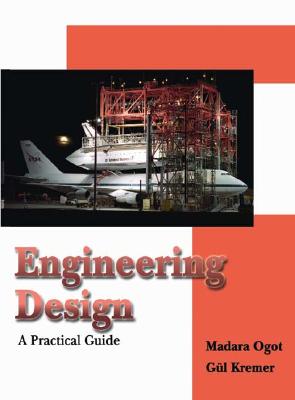You are here
Back to topEngineering Design: A Practical Guide (Paperback)
This book is non-returnable.
Description
Successful engineering design requires a strong understanding of fundamental concepts in the basic sciences and engineering combined with mathematics. This text provides an introduction to the design tools used in engineering design. It focuses on the first two steps of the design process: determination of need/problem clarification and conceptualization.
In addition, an overview of materials and manufacturing methods is presented. The use of Excel has been incorporated throughout the text for performing routine calculations, leaving more time for the creative aspects of the design process. Finally, the text contains an extensive discussion of systematic concept generation using the theory of inventive problem solving, TRIZ.
Below is a listing of the book's table of contents:
1. Engineering Design
1.1 Design
1.2 Engineering Design
1.3 Process Design
1.4 Overview of the Engineering Design Process
1.5 Design Reviews
PART I ENGINEERING DESIGN AIDS
2. Management of the Design Process
2.1 Introduction to Project Management
2.2 Planning and Scheduling (includes discussion of work breakdown structures, design structure matrix, activity networks and Gantt charts). Provides an automated MS Excel-based project management workbook that incorporates all these tools).
2.2 Directing
3. Collaborative Design
3.1 Introduction
3.2 Conceptual Understanding of Teams and Team Development
3.3 Challenges: Conflict Management, Performance and Motivation
3.4 Communication
3.5 Potential Factors Impacting Team Performance
4. Engineering Communication: Reports and Oral Presentations
4.1 Introduction
4.2 The Formal Engineering Report
4.3 Plagiarism
4.4 Report Formats
4.5 Oral Presentations
4.6 Poster Presentations
5. Engineering Communication: Illustration and Solid Modeling
5.1 Introduction
5.2 Introduction to Digital Media
5.3 Technical Sketching and Solid Modeling
5.4 Working Drawings
5.5 Computer Generated Sketches for Documentation
6. Decision Making
6.1 Introduction
6.2 Rank Order: Pairwise Comparison Charts
6.3 Relative Order: Analytic Hierarchy Process (AHP)
6.4 Relative Order: Decision Matrices
PART II THE ENGINEERING DESIGN PROCESS
7. Problem Definition and Determination of Need
7.1 Introduction
7.2 Problem Definition
7.3 Determination of Customer/Client Needs
7.4 Revised Problem Statement
8. Conceptualization I: External Search
8.1 Introduction
8.2 Patents and Patent Searches
8.3 Benchmarking
8.4 Product Dissection
8.5 Biomimicry
9. Conceptualization II: Internal Search and Concept Selection
9.1 Introduction
9.2 Internal Search (Includes discussion on concept generation methods such as brain storming and its variations, Delphi method, synetics, checklists, scamper and morphological charts).
9.3 Concept Selection (Use of Pugh charts and decision matrices)
10. Systematic Innovation with TRIZ
10.1 Introduction
10.2 Simplified Steps for Application of TRIZ tools
10.3 Analyzing the System and its Resources
10.4 The Ideal Final Result
10.5 The 40 Design Principles
10.6 Technical Contradictions and the Contradiction Matrix
10.7 Physical Contradictions
PART III Overview of Materials and Manufacturing
11. Materials and Material Selection
11.1 Introduction
11.2 Materials and Material Selection
11.3 Mechanical Properties of Materials: Stress-Strain
11.4 Typical Mechanical Properties for Material Selection
11.5 Typica.
